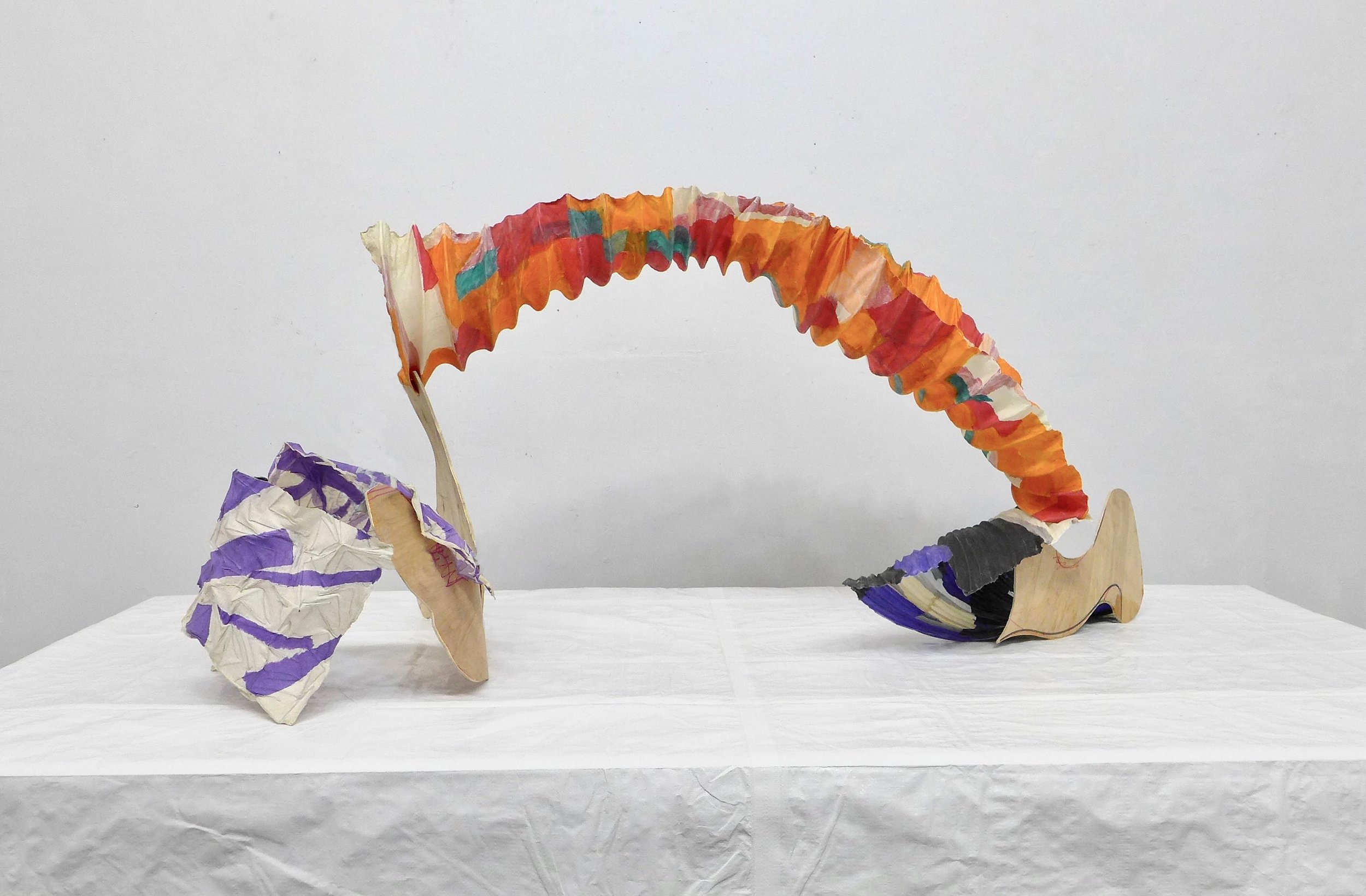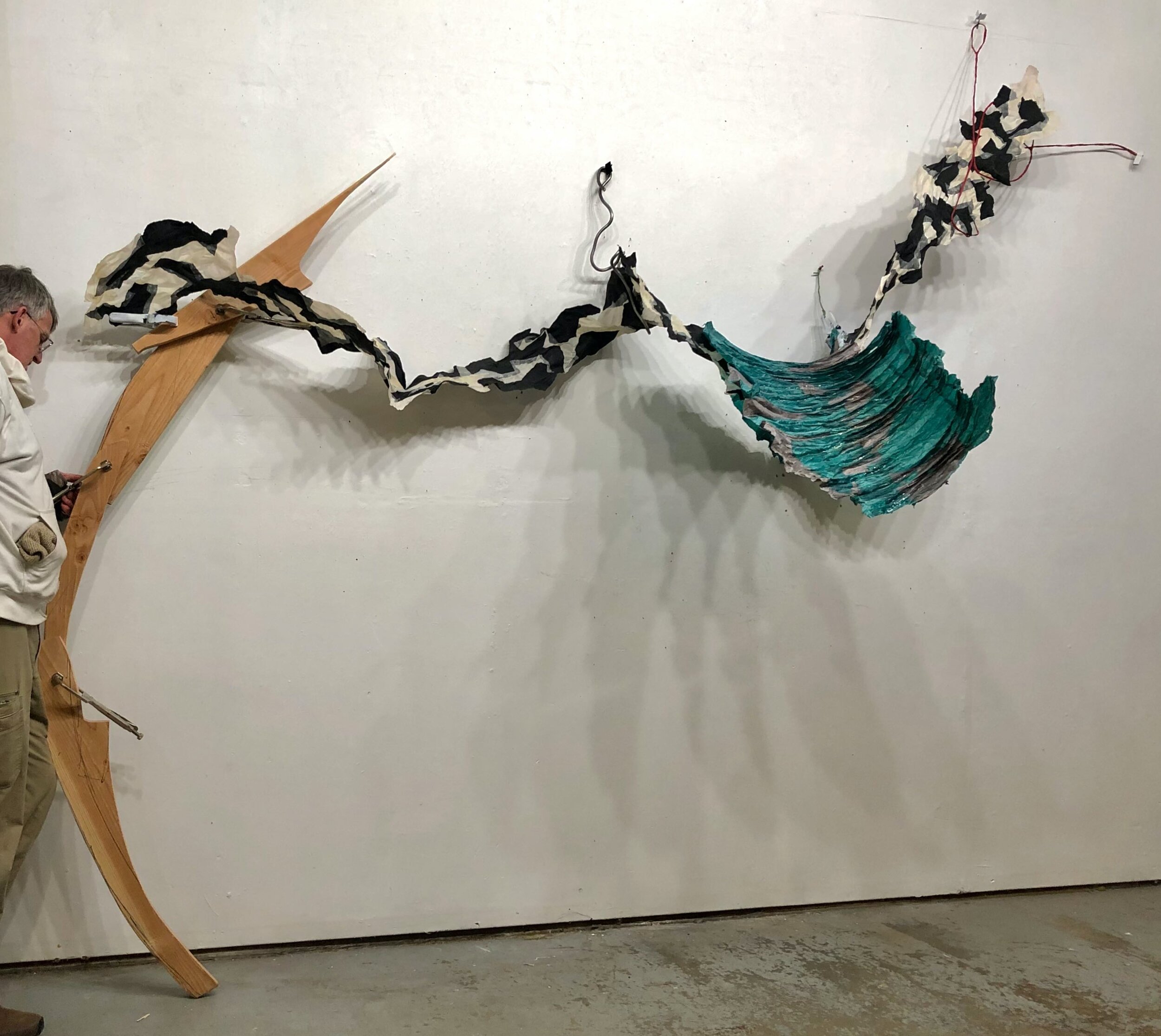If you don’t like the art, wait 10 days.
Project proposal -
In a shop window on a busy street, make a work. 10 days later, recompose & rearrange its parts - sometimes dramatically, sometimes simply - into a new work and leave for 10 days. Repeat.
We don’t yet have a window in which to do this, but imagine this series as a good example of what we’d like to produce when we get one.
This first variation is made by putting together a couple of elements with temporary attachments. We liked how the green, webby abaca element awkwardly latches onto the colorful accordion shape which seems intent on gliding away.
variation 1
We’d leave the piece be for 10 days. Then we’d document it before taking it apart and rearranging the parts until we found a worthy successor composition. We might add or take away a few or a lot of components and add others. It might take several hours or a couple of days. Once we have it, we’ll wait 10 days and repeat.
variation 2
We found ourselves trying to get the colorful accordion into the air by adding some bent plywood shapes and the black & purple accordion as supports. Our 1st attempt at a bridge gave way, but we liked the resulting heavy, strong horizontal composition.
In this day and age, “art without a cause” is looked down upon.
If the art is not a rental car for political or cultural issues close to head and heart, do people shrug, "Yeah, so, I mean, I don't dislike it, right?"
What would a dialog only and all about the art sound like? Would it stay about the art?
We want to create a series of compositions rather than build towards a single finished work. We want to show our works in the spirit of how we work.
Why do we assume the bones of a sculpture can produce only one compelling skeleton? We like the analogy of a troupe of competent actors reappearing in different roles.
variation 3
The purple and white pieces which are stiffened with bobby pins help secure or weigh down the left side of the accordion as it reaches out and up to the base on the right.
variation 4
By rearranging the purple and white forms, we managed to get the accordion shape suspended over the table top.
In the shop window, we’d leave a few clamps visible to make it clear our compositions are temporary solutions. Other clamps would get swopped out for some hidden stitching, magnets or velcro.
The take away from our residency in the shop window will be a series of photographs of the works made from the same group of objects.
variation 5
The accordion mimics a figure in a backbend.
Each 10 day variation shares more or less the same bones with the others. We want to create strong, distinctive works that are even more compelling as a group of works not just in the same style but of the same components. Seeing the same parts in different compositional roles allows the works to finish, augment, or reinterpret each other.
variation 6
The lime, red and grey abaca strapping help turn the colorful accordion into a base in order to hold the much smaller accordion aloft between it and the curving base of overlapping elements on the right.
The works above are also in the gallery below.
This second ‘wait 10 days’ example focused from the start on the interaction between the 2 plywood figures. The variations are more linear in their relationships, almost like stills in a film.
We pushed the 2 figures further apart trying to find the maximum distance they could maintain without splitting into 2 distinct works.
trying to design a place of wonder nearby, 2019 handmade cast abaca and cotton papers, pulp painting, pastel, painted wood, tape, bamboo, fencing wire, height seems a steady 7’ to 8’ while width varies from 5’ to 11’ We revisited this compositional idea on For the other side.
finding a path to what we’ve turned our backs on, 2019 handmade cast abaca and cotton papers, wood, insulation foam board, fencing wire, dimensions vary though as a guide the white side panels are 8’ high. See a later variation For the other side
It’s about art that is inspired by its making and remaking.
There’s resonance and relevance beyond that of a simple studio exercise of keeping busy with limited materials.
When we leave the shop window at the end of our run, we will have produced several works that only survive in photographs or as memories of vacations, holidays, or reunions are remembered. Maybe, it’s a travelogue of a journey whose destination is unimportant? Unlike memories, all the works can be re-created one at a time.
Are the individual works simply related works or comprise a single large work made over time reworking mostly the same elements?
LandesSullivan at gmail.com














